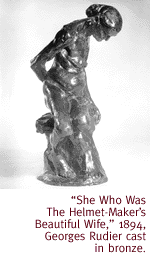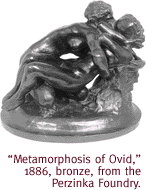

|

Rodin In All His Brilliance And Mediocrity.
By Margaret Regan
LOOKING TODAY AT Rodin's "The Thinker," which
strikes us as the epitome of artistic cliché, or at one
of the artist's sentimental sculptures of doomed lovers, all writhing
arms and furrowed brows, one is hard pressed to understand what
all the fuss was about a century ago.
Even Rodin's groundbreaking sculptural techniques--the artist's
fleshprints preserved in the yielding clay and reproduced in sturdy
bronze--have been so much imitated that we fail to register how
innovative they once were. Yet in his early days Auguste Rodin
was a radical artist, an outrageous rebel against classical sculptural
tradition. In the declining decades of the 19th century, the French
arts establishment--including the Academy and the Ecole des Beaux
Arts, which three times rejected Rodin as a student--saw Rodin's
naturalistic figures as an affront to the loftiest aesthetic ideals.
 A crowded new show at the University of Arizona Museum of Art
traces Rodin's changing fortunes from art-school reject to idolized
éminence grise. A photo reproduction even captures
his grandiose funeral in 1917. Rodin: Sculpture from the Iris
and B. Gerald Cantor Collection offers up dozens of bronze
castings of Rodin's work, some of them in miniature versions,
dating from 1876 to 1910. (Castings are made from the clay originals
owned by the French government.) The show highlights some of the
artist's signature works, including the much-reproduced "Thinker"
as well as other figures originally intended for his famous "Gates
of Hell." There are elements from his monumental "Burghers
of Calais," and assorted versions of the portrait of Balzac.
Along the way the exhibition persuades doubters, jaded by years
of Rodin reproductions and sentimental rip-offs, of the singularity
of his achievement.
A crowded new show at the University of Arizona Museum of Art
traces Rodin's changing fortunes from art-school reject to idolized
éminence grise. A photo reproduction even captures
his grandiose funeral in 1917. Rodin: Sculpture from the Iris
and B. Gerald Cantor Collection offers up dozens of bronze
castings of Rodin's work, some of them in miniature versions,
dating from 1876 to 1910. (Castings are made from the clay originals
owned by the French government.) The show highlights some of the
artist's signature works, including the much-reproduced "Thinker"
as well as other figures originally intended for his famous "Gates
of Hell." There are elements from his monumental "Burghers
of Calais," and assorted versions of the portrait of Balzac.
Along the way the exhibition persuades doubters, jaded by years
of Rodin reproductions and sentimental rip-offs, of the singularity
of his achievement.
The show begins with "The Age of Bronze," an 1876 nude
that was the first piece Rodin ever exhibited. (The nude, Rodin
once said, was "a real religion with me," and he stayed
with it his whole career.) To a modern eye, this heroic male looks
eminently noble, eminently respectful of tradition. But it broke
just about all the art rules of the day. Like the Impressionists,
his painterly contemporaries, Rodin came of age at a time when
French neo-classicism had deteriorated into stultifying rigidity
(he was born in 1840). Sculpted figures were supposed to be of
ideal proportions, not the lumpen dimensions of ordinary mortals.
They had to allude to historic or mythological events, and though
nude they were to be spiritual, not sexual; restrained, not emotional.
For "The Age of Bronze," Rodin used the proportions
of a normal man (furious critics accused him of making a casting
from a real-life human). Moreover, the fellow's just a nude and
nothing more; he carries no symbolic arrow and wears no allusive
garments--no Greek helmet, no Roman toga--to elevate him beyond
mere flesh.
 It's a fine little piece, but it doesn't begin to suggest the
passion and sexual energy of Rodin's subsequent work. An 1875
trip to Italy made of the Frenchman a fervent disciple of Michelangelo's
billowing, muscular bodies. "Michelangelo," he wrote,
"freed me from academism." Like Michelangelo, Rodin
was happy to distort the body when it served his purposes, exaggerating
the ripple of muscles across a back, enlarging hands to gargantuan
size. Even "The Thinker" has a powerful muscularity
that simultaneously suggests profound thought and robust physicality.
It's a fine little piece, but it doesn't begin to suggest the
passion and sexual energy of Rodin's subsequent work. An 1875
trip to Italy made of the Frenchman a fervent disciple of Michelangelo's
billowing, muscular bodies. "Michelangelo," he wrote,
"freed me from academism." Like Michelangelo, Rodin
was happy to distort the body when it served his purposes, exaggerating
the ripple of muscles across a back, enlarging hands to gargantuan
size. Even "The Thinker" has a powerful muscularity
that simultaneously suggests profound thought and robust physicality.
Despite his innovations and bad-boy reputation, Rodin began attracting
public commissions by the 1880s. He often struggled with these
paid jobs, grappling between his creative impulses and the hidebound
expectations of those holding the pursestrings. In "Balzac
Athlete 'F,' " he tried to compress the noted French author's
prodigious literary and sexual energies into a single form: a
fat, muscular man with a leonine head, his hands hovering over
his penis. Not surprisingly, this version created an uproar. A
tamer one, with Balzac conventionally clad in a robe, a pile of
books beside him, apparently failed to satisfy the artist. The
extraordinary final version, pictured here only in a photograph,
concentrates on the author's huge head, all fleshy lips and wild
hair; it's placed atop a stark figure that heralds the stripped-down
forms of modernism.
But, straddling the centuries, Rodin seemed torn between the
old ideas and the new. He was capable of penetrating psychological
studies, like the Balzac, but he also indulged repeatedly in tired
mythological subjects. He returned numerous times to the theme
of doomed lovers, such as "Paolo and Francesca," an
1889 work based on Dante characters. Goofy cherubs romp in the
1876 "Idyll of Ixelles." The perfectly awful "Call
to Arms," 1883, a maquette for a war memorial, features a
shrieking female harpy with wings. (Rodin didn't get the commission.)
It's hard to reconcile these almost trivial pieces with Rodin's
more serious works, masterful solitary figures that evoke what
the French like to call the human condition: sexuality, loneliness,
death. "Head of Sorrow," 1882, a head thrown back in
grief, is a beauty. So is "She Who Was the Helmet-Maker's
Beautiful Wife," 1887, a compassionate portrait of a woman's
body in old age. "Meditation," 1885, is its counterpoint:
a young female nude, lovely and ripe.
 The transcendent figures of "The Burghers of Calais"
(1884-1895) prove that when Rodin wanted to, he could rise above
pedestrian public expectations. The town of Calais had commissioned
the work to commemorate six heroes of the Hundred Years' War of
the 14th century: These worthies had offered up their own lives
to the English in exchange for an end to the siege of the starving
town. (An English queen ultimately spared their lives.)
The transcendent figures of "The Burghers of Calais"
(1884-1895) prove that when Rodin wanted to, he could rise above
pedestrian public expectations. The town of Calais had commissioned
the work to commemorate six heroes of the Hundred Years' War of
the 14th century: These worthies had offered up their own lives
to the English in exchange for an end to the siege of the starving
town. (An English queen ultimately spared their lives.)
Rodin could have made the sort of hail-fellow public monument
of the kind that nowadays has its echoes in corporate reports'
smarmy photographs of their titans. Instead, he made riveting
portraits of six men about to die, deftly moving from their particular
historical anecdote toward the larger theme of humanity's inevitable
march toward death. The men are at varying stages of life, and
they edge toward death separately and alone. They're not in conventional
heroic postures, either: They bow their heads in sorrow, in meditation,
in regret. The show includes only a photograph of the final grouping,
but the individual sculpted figures are here. Their faces, especially
the "Monumental Head of Pierre de Wiessant," are some
of the most beautiful, most profound, human heads ever sculpted.
Rodin: Sculpture from the Iris and B. Gerald Cantor Collection
continues through January 27 at the University of Arizona Museum
of Art. Art Historian Barbara Churchill will give a free talk
on Rodin at 12:15 p.m. Wednesday, December 10. Sunday Family Arts
workshops offer tours and children's clay workshops from 1 to
4 p.m. on December 7 and January 11. Spaces are limited. Regular
museum hours are 9 a.m. to 5 p.m. Monday through Friday, noon
to 4 p.m. Sunday. For more information, call 621-7567.

|
 |





